By David Burke.
Introduction.
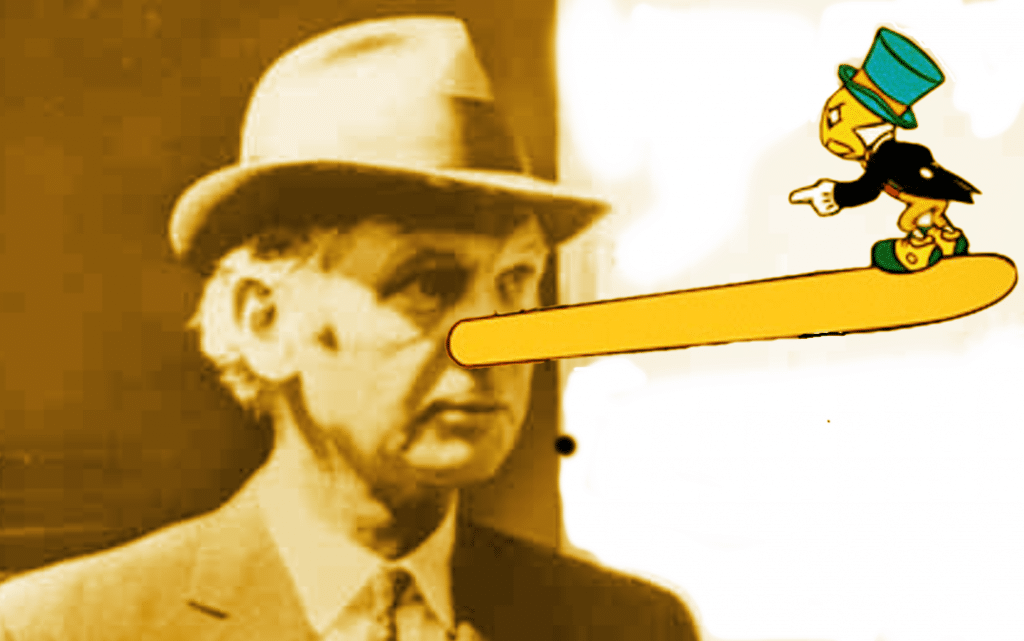
The story of the Arms Crisis is a perfectly simple one. It only becomes complicated when the lies, fantasies and myths that engulfed it are entertained as if serious.
Only two participants in the débacle told the full, accurate and unvarnished truth: Captain James Kelly and Colonel Michael Hefferon, both dutiful officers of Irish Military Intelligence, G2.
It is my intention to publish a book next September which will reveal the deepest secret of the affair, aiming to make it even easier to comprehend.

For the most part, I have ignored the parallel story of how the truth was washed away by a flood of hogwash because it does little more than confuse the narrative. However, I will take this opportunity to present some of the more dramatically erroneous materials that made it into print. In other words, this is the story of what did not happen during the Arms Crisis and its aftermath.
When the vines of deceit which wrapped themselves around the story are stripped away, what really happened in 1969/1970 becomes clear: James Gibbons, the Minister for Defence, 1969-70, oversaw an operation to import arms which were to be stored in the Republic under Irish Army lock and key. Charles Haughey and Neil Blaney were deeply involved too. Blaney was probably the main protagonist in the affair. Jack Lynch knew about it too.
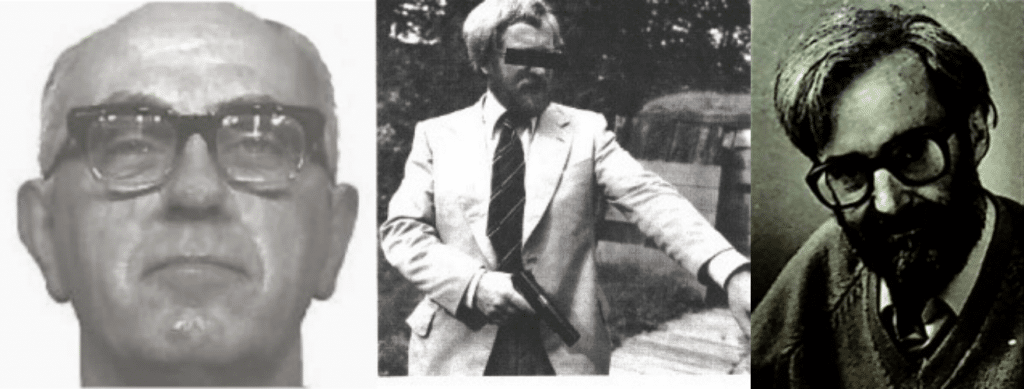
The paedophile, the propagandist and the political correspondent: William McGrath, Hugh Mooney and Dick Walsh.
The weapons – which never reached Ireland – were intended to be distributed to certain vulnerable Catholic communities in Northern Ireland but only in the extremely unlikely event of a ‘doomsday’ situation such as a pogrom.
Since no ‘doomsday’ scenario in fact occurred, the weapons would have done little more than gather dust and might have become no more than a minor footnote in recent history. All that changed when news of the importation attempt leaked out and all political hell broke loose.
History was corrupted by a motley crew comprising a group of paranoid and malicious paedophiles who surrounded Ian Paisley, a cabal of deceitful British Intelligence propaganda experts, a Taoiseach who dissembled under great pressure – as did his minister for defence, a collection of delusional Official Sinn Féin activists, a legion of profoundly ignorant British journalists, and finally Dick Walsh, a secret ally of the Official OIRA in the Irish Times. This ramshackle crew concocted a variety of gobbledygook conspiracy theories. Broadly speaking, they can all be boiled down to a simple and core allegation, namely that the arms were destined for the IRA as part of some sort of dastardly plot involving Charles Haughey.
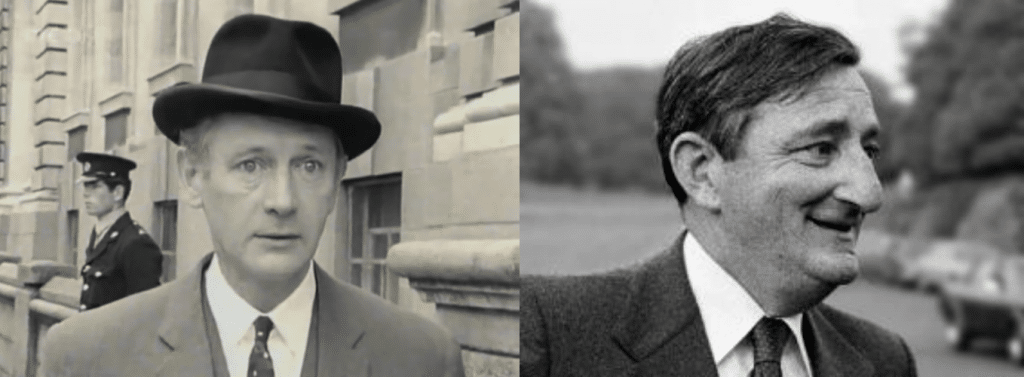
Lying on an industrial scale: Jack Lynch and Jim Gibbons. One of the reasons the Arms Crisis became so confused was because of the hogwash they spouted about it.
1969: INTRODUCING THE EXTREMIST LOYALIST CHILD-RAPIST, ORANGEMAN, BIGOT, THIEF, BOMBER AND TERRORIST WHO INSTIGATED THE FIANNA FÁIL-IRA SMEAR
All the trace elements of the Arms Crisis myth can be found in a devious story published in the pro-Paisley newspaper, The Protestant Telegraph, in 1969.
A group of extreme Loyalists zealots including ‘Dr’ Ian Paisley, his associate William McGrath, and Paisley’s one-time bodyguard, John McKeague, and one of McKeague’s friends, Alan Campbell, ratcheted up sectarian hatred in the 1960s in tandem with other like-minded bigots. McGrath was a vile creature: a notorious paedophile who would be convicted for child rape in December 1981. The RUC referred to him as ‘The Beast’. McKeague was worse; not only was he a child rapist but his depravity extended further – he became a UVF/Red Hand Commando serial killer and torturer. He would be murdered in February 1982 after he threatened to reveal what he knew about the Kincora Boys Home scandal when it looked like the RUC CID was on the verge of arresting him for rape. Alan Campbell was one of the three men who led the notorious Shankill Defence Association alongside McKeague. Campbell was also the RUC’s chief suspect in the abduction and murder of a ten-year-old boy in 1973 in Belfast.
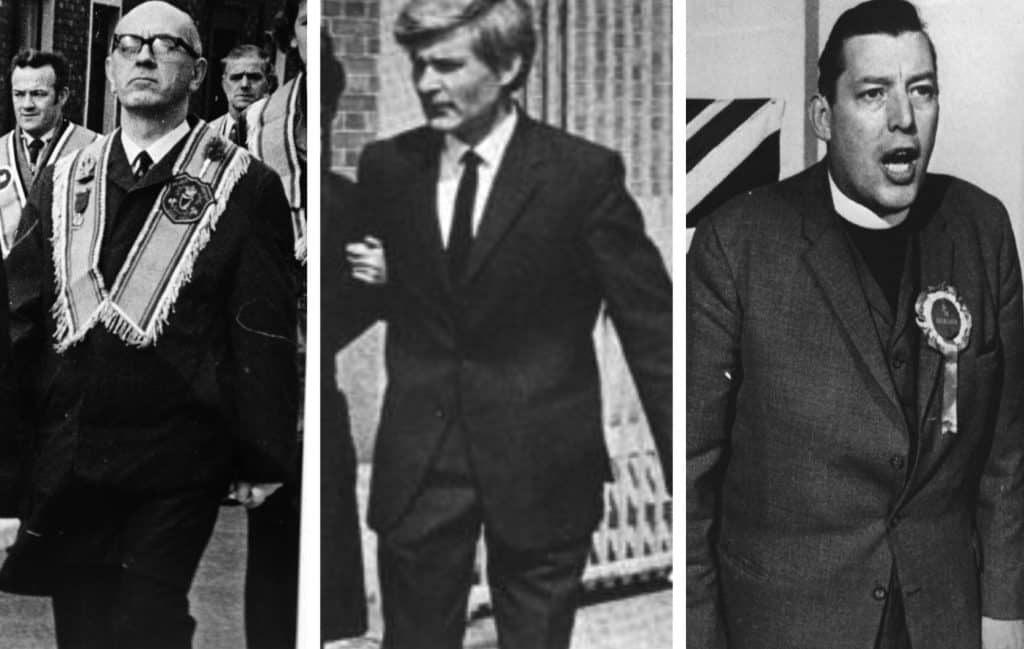
McGrath, McKeague and Paisley
Back in April of 1969, McGrath, McKeague, Paisley and other hate-fuelled fanatics mounted a ‘false flag’ bomb campaign in the North, i.e. one they perpetrated but blamed on the IRA and Jack Lynch’s government. The most notorious bomb of the campaign was the one which exploded in the Silent Valley and cut off the water supply to parts of Belfast. At the time the IRA hardly existed and certainly had no intention of launching any sort of military campaign against the NI State.
The allegation that the April 1969 bombs were part of an IRA campaign was circulated in the pro-Paisley newspaper, The Protestant Telegraph. It declared deceitfully that a source “close to [Stormont] Government circles” had informed the paper that a purported “secret dossier” on the Castlereagh electricity sub-station explosion contained:
“startling documentation and facts. Original reports suggested that the IRA could have been responsible, but in Parliament no such definite statement would be made…We are told that the Ministry of Home Affairs is examining reports which implicate the Eire Government in the £2 million act of sabotage — By actively precipitating a crisis in Ulster, the Eire Government can make capital, win or lose. The facts, we hope, will be made public, thereby exposing the chicanery of the Dublin regime”.
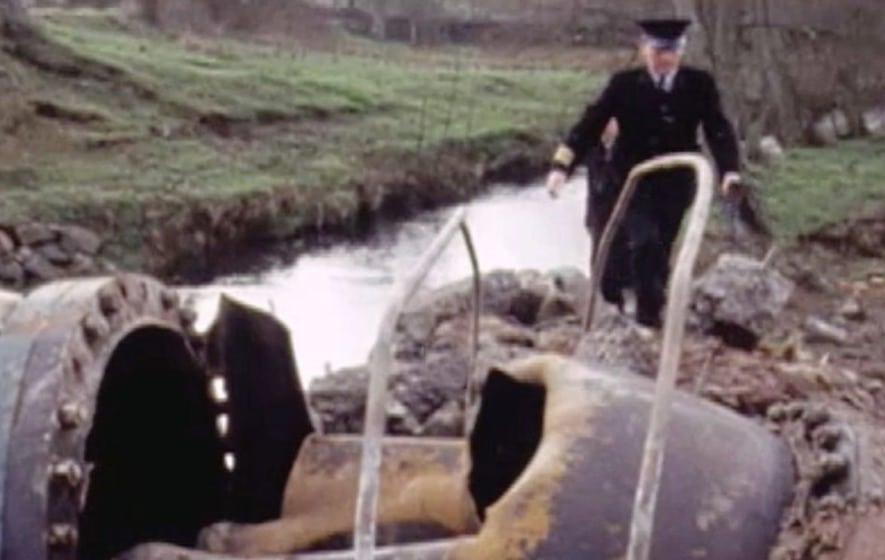
The Irish government ignited the Troubles – if you believe McGrath – by bombing the water supply to Belfast. This picture shows some of the débris left after the Silvent Valley bomb explosion actually perpetrated by supporters of Ian Paisley. William McGrath blamed Fianna Fáil for it.
These lies would be laughable but for the vitriol they helped whip up in extreme Loyalist circles.
McGrath was the main promoter of the lie. He used the then deputy editor of the Protestant Telegraph, David Browne, as his conduit to plant the story in the paper. Browne had been present at a meeting in McGrath’s house at Greenwood Avenue on the Upper Newtownards Road a few hours after one of the April 1969 bombs had exploded. Addressing the gathering, McGrath had told his gullible audience that the attack had been carried out by a special unit attached to the Irish Army, nominating an individual called “Major Farrell” as its leader. Farrell was a figment of his imagination. According to him this invented character’s mission was to destabilise the North as a precursor to an invasion by the Republic. Browne later became editor of the newspaper. [Chris Moore, ‘The Kincora Scandal’, p 61/4].
LYING ON AN INDUSTRIAL SCALE: THE ARMS CRISIS ERUPTS
A little over a year later, McGrath and Paisley woke up to learn that Jack Lynch had fired Neil Blaney and Charles Haughey from his cabinet for allegedly trying to import arms illegally. This development played directly into their paranoid view of what was taking place in Ireland.
Significantly, Lynch protected Gibbons who had been directing the effort through the operational activities of Captain James Kelly of Military Intelligence, G2. There are many reasons why he did this – a story for another day – but the bottom line is that he did not tell the truth about what had happened and his role in it.

‘Honest’ Jack: he lied to the Dáil and oversaw a dirty-tricks campaign in the lead up to the Arms Trials designed to pervert the course of justice.
Unfortunately, events took on a life of their own and lying commenced on an industrial scale. Over the next few months, the Dáil would be misled repeatedly by Lynch, documents would disappear, forgeries would come into existence, witness statements would be altered and perjury would flow from Gibbons in the witness box. Yet, despite this elaborate confection of deceit, the jury was not fooled and Captain Kelly, Haughey and the other Arms Trial defendants were all acquitted.
On the negative side, the volcano of lies that spewed after the Arms Crisis and the two Arms Trials added apparent substance and impetus to McGrath’s sulphuric myth that Fianna Fáil was acting in league with the IRA.
1970: PRIVATE EYE IN LONDON GETS EVERYTHING WRONG
The IRA split into the Official and Provisional factions in December 1969 with a similar division in Sinn Féin in January 1970.
Official Sinn Féin agents began to feed their astonishing imagined version of the Arms Crisis to Paul Foot, a left-wing activist who wrote for Private Eye magazine in London, after the outbreak of the Arms Crisis in May 1970. The end result was a staggering mishmash of lies, speculation and fantasy. This is a shame for Foot who later emerged as one of Britain’s most able campaigning journalists. His Private Eye reports are a serious – albeit exceptional and rare – blot on his notebook. Foot should not have trusted his Irish socialist brethren so readily.
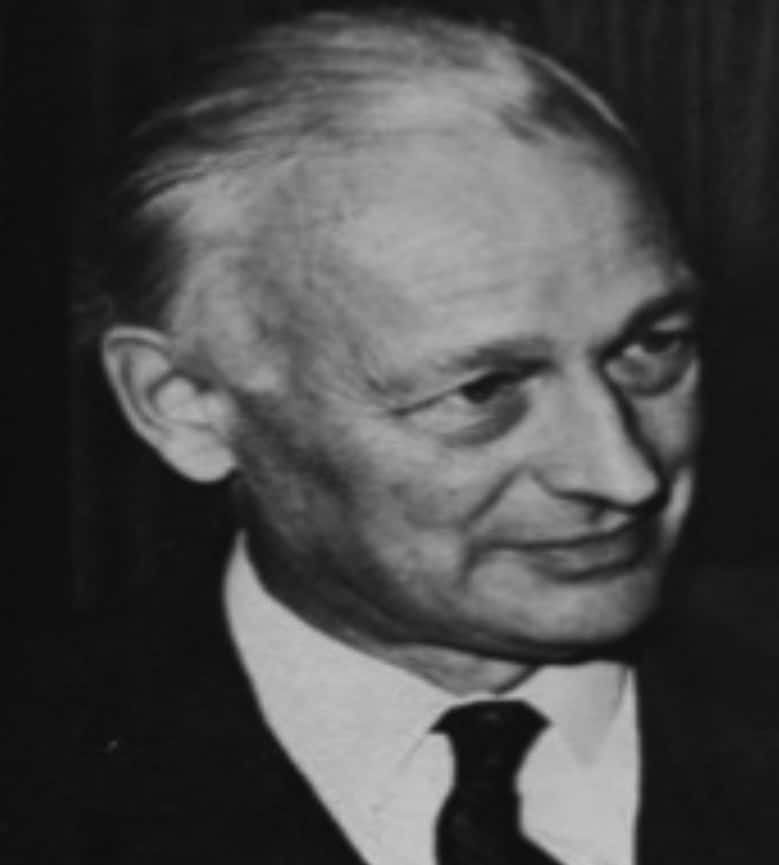
Ambassador John Peck who did not tell Liam Cosgrave about the attempt to import arms by Irish Military Intelligence.
Foot’s coverage did not lack for drama:
“On 14th April, the British ambassador [John Peck] called on Lynch and informed him that British intelligence had knowledge that a shipment of arms was due to be run into Dublin on 20th April [1970]. That night 11 Army officers including Paddy ‘Jock’ Haughey, the brother of Charles Haughey, were arrested and taken to Dublin Castle. When Charlie Haughey heard of his brother’s arrest he drove furiously to the Castle to demand his brother’s release. The next morning it was announced that he had been taken to hospital following a riding accident, and Haughey himself has insisted that this is the real explanation. What no one has yet explained is how Haughey’s bodyguard came to be injured and admitted to the same hospital at the same time”.
Nearly every word in the foregoing paragraph is misleading: not a single army officer was arrested; Jock Haughey was not an Army officer; he was never arrested and his brother did not go near Dublin Castle to rescue him. Haughey’s “bodyguard” was in fact a Garda special branch driver and would never have joined anyone in a fist fight at the office of Chief Superintendent John Fleming’s at the HQ of the Special Branch at Dublin Castle. And in any event, when arrests were eventually made, the prisoners were taken to the Bridewell, not Dublin Castle.

Punch-up: if we are to believe risible Official Sinn Fein sources, Haughey and his Special Branch bodyguard went up to the HQ of the Special Branch where they started a fight that landed Haughey and his bodyguard in hospital together.
The Eye story also gave birth to one of the most fantastic myths of the Arms Crisis: that Haughey and others had advocated an invasion of the North, which of course is a part of the UK. In other words Haughey wanted to risk war with a nuclear power with a massive air force, army and navy. According to Foot, “The key to the whole crisis originates in the crucial Cabinet meeting in August (1969) when the Irish Cabinet divided 5-7 on the motion to invade Northern Ireland (see Issue 203). When this happened, five ministers, Blaney, Haughey, Boland, Flanagan and O’Móráin threatened to resign, and appeal to the party and country against Lynch (see issue 203)”.
No such vote was ever taken.
Kevin Boland and Des O’Malley (present in his capacity as chief whip) are adamant no such proposal was ever mooted. Yet, The Eye asserted confidently:
“Knowing that such a move would undoubtedly bring down his Government, Lynch accepted a compromise policy moved by Gibbons, the Defence Minister, and seconded by Hillery, the Foreign Minister. It was agreed inter alia that Hillery should go to London and inform Wilson that the Irish Army would move into the Bogside if the British Army didn’t take steps to raise the siege; that Haughey the Finance Minister, should raise an emergency loan in Germany of £10 million for the purchase of arms for the Irish Army. (It had been reported to the Cabinet that the Irish Army had enough artillery shells to last only 12 hours). A Northern sub-committee of the Cabinet would be set up to direct day-to-day operations in the North. This was to consist of Boland, Haughey, Blaney and Gibbons with Lynch as an ex officio member”.
The are numerous mistakes here. Boland and Gibbons were not members of the sub-committee. Padraig Faulkner and Joseph Brennan – who are not mentioned – were members, although they had abandoned their posts after one meeting.
The Eye nonsense kept flowing: “The cream of the officers of the Army were sent into the North to organise the defence of the nationalist areas. These officers included the Irish experts on irregular warfare”. What in fact happened was quite the opposite: later on, a number of men from Derry were given training at Fort Dunree in Co. Donegal. Ironically, The Eye would report that occurrence more or less accurately.
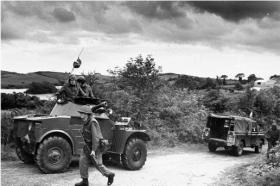
The Eye then returned to its coverage of the NI sub-committee. It is a fact it met once after which Blaney and Haughey failed to attend the next meeting and Faulkner an Brennan lost interest. Yet, according to The Eye, the committee was very active indeed:
“With the aid of Peter Berry, secretary to the Department of Justice, a special section of the special Branch called MWO was set up, ostensibly to protect the lives of ministers – in fact, to spy on them. This organisation worked in very close cooperation with British MI6 who moved five senior agents to Dublin for this purpose. With the aid of MI6, the Customs House in Dublin, head office of the Irish Department of Local Government and headquarters of the Northern sub – committee of the Cabinet was ‘bugged'”.
Since the sub-committee did not have meetings, and did not have an office, it would have been impossible to have bugged it no matter how many MI6 agents Berry had let loose on Dublin.
There is more: no purge of the Army took place. Yet, according to Foot:
“In January this year (1970), while newspapers concentrated on the Fianna Fail party convention, a large and extensive purge of the Irish Army was carried out. Officers known to be in favour of militant action in the North were retired, removed, replaced, changed. Some at least of these officers wanted to resist but were prevailed on by Haughey to take no action as he believed that given a Northern crisis he could remove Lynch. The changes in the Army had alerted Haughey to Lynch’s intentions and he began to take steps to counteract them. Neither Lynch nor Haughey at this stage wanted a head-on confrontation. Lynch, because he needed more time to assure himself of the support of the Parliamentary party and the Army. Haughey because he believed that given a Northern crisis he could constitutionally and easily replace Lynch”.

A trusting comrade: the Socialist Workers Party activist Paul Foot who wrote for Private Eye magazine. His hugely impressive legacy is tainted by the fiction fed to him by Official Sinn Féin/IRA sources in 1970 that resulted in a series of laughable reports in Private Eye.
The notion that Haughey was exploiting the crisis to replace Lynch emerged as yet another myth of the crisis. It was mooted by Foot. Sixteen years later, Dick Walsh, who had worked in Britain in the 1960s, and later became a political reporter for the Irish Times was still banging this drum. He did so in his book on Fianna Fail.
According to Foot’s far-fetched account, Haughey had massive support in the Army for his various machinations. This nearly led – if we are to believe The Eye – to a shoot out between the Army and Special Branch:
“The Army officers, with one exception, refused to make any statements when interrogated by members of the MWO section of the Special Branch. Following these arrests Army officers who had been involved in intelligence work in Ulster assembled in Columb Barracks, Mullingar. When members of the Special Branch attempt to enter this barracks to interrogate officers, they were shown the business end of a sub-machine gun and told in no uncertain terms to go away”.
Don’t be worried if this is getting all a little too confusing. It can be dismissed for what it was: utter rubbish.
In this fantasy account Lynch was told about the tension between the army and police:
“When this was reported to Lynch he called in the chief of staff of the Army whom he had earlier consulted about the allegiance of the Army. At this meeting, it was reported that a senior GHQ officer told Lynch that if the arrests and interrogation of Army officers was continued it would impose ‘an intolerable strain’ on the allegiance of army officers. This is believed to be a reference to the red-alert stand by that night of all units of the 6th Brigade. It is believed that only a phone call from one of the dismissed ministers stopped this unit from visiting Dublin to have words with the special Branch units who arrested the Army officers”.
Incredibly, there was no 6th Brigade in the Irish Army. There might have been six brigadiers, but no 6th Brigade. So we can add a fantasy army to Foot’s errors.
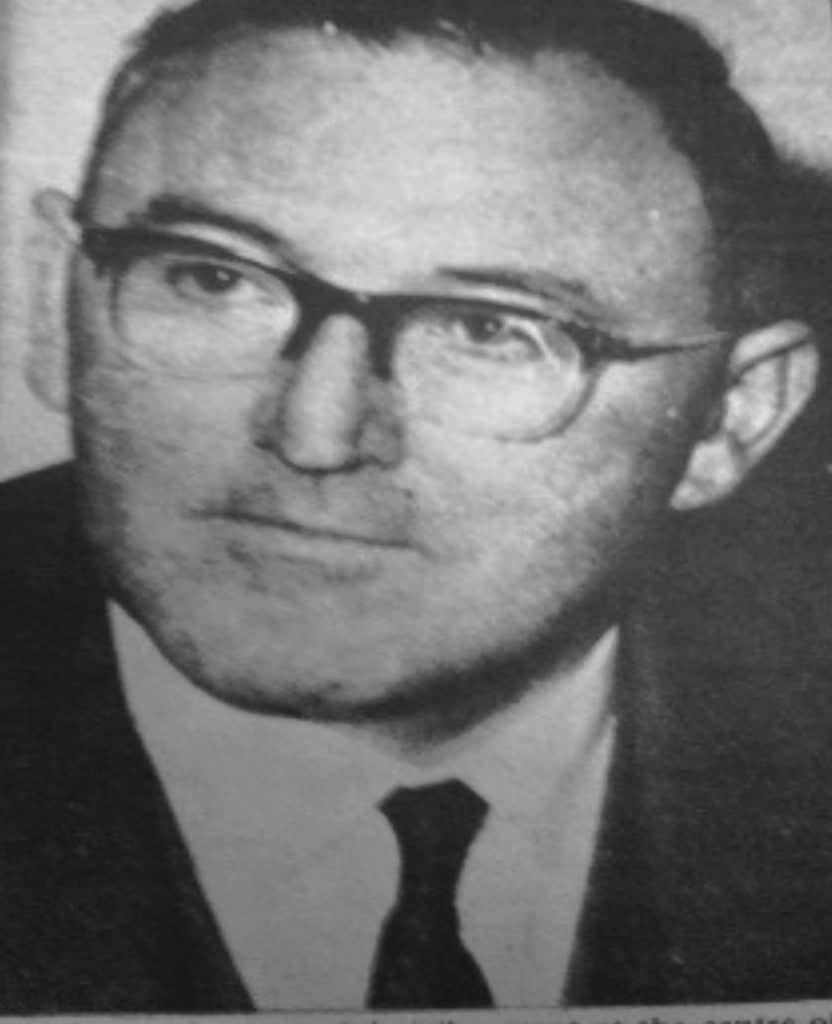
Our man in Dublin: According to the Official Sinn Féin/IRA sources who misled Private Eye magazine in London, Peter Berry, the Secretary of the Department of Justice, worked with five MI6 officers to spy on his own government.
It gets yet even more fantastic:
“At this stage it appeared that Lynch might retreat, but on 30th April [1970], the British Army mounted Operation ‘Mulberry’. Ostensibly this was to be a search of the Border counties for arms. But it was interpreted by the Irish general staff as the first stage of an operation to help disarm certain units of the Irish Army. Lynch was informed by the Irish general staff who insisted that Lynch take action one way or another to clarify his position. Coinciding with this, the British Ambassador and an un-named senior Irish civil servant (Peter Berry) met together and decided to put further pressure on Lynch. A copy of the report drawn up by Chief Supt Fleming of MWO was leaked to the Sunday Independent. On Tuesday, 5th May, the British Ambassador gave Liam Cosgrave, the leader of the opposition, a full account of what had happened and a copy of a British police report, plus photographs, showing that a relative of one of the dismissed ministers had visited the Continent in company with the man currently wanted for bank robbery in Ireland, and asked him to raise it in the Dail”.
Nothing remotely of this nature actually happened.
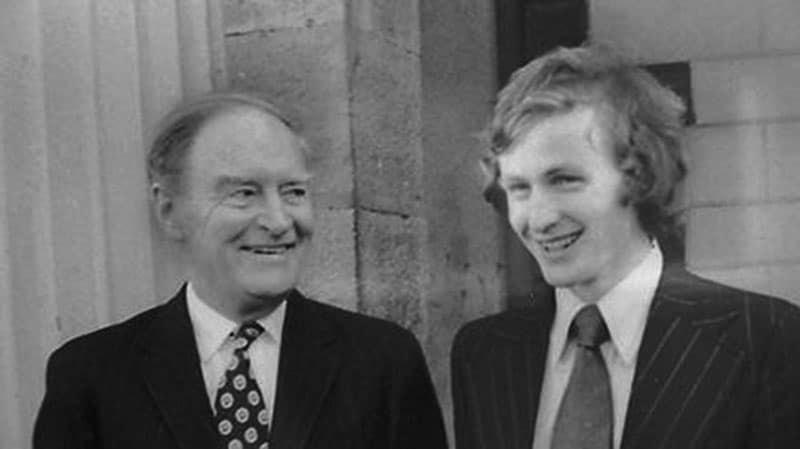
Contacting Cosgrave: According to Private Eye’s Official Sinn Féin/IRA sources, the British Ambassador John Peck tipped off Liam Cosgrave about the arms-importation operation. This is not what happened.
In the fantasy account in The Eye, Cosgrave accepted the British report from the ambassador and “agreed and, in fact, informed Lynch of his intentions. Within hours Lynch dismissed Haughey and Blaney”.
In reality, Cosgrave received his information about the arms importation attempt from two separate Garda sources.
THE CRAZY ALLEGATION THAT JACK LYNCH, ERSKINE CHILDERS AND DES O’MALLEY OFFERED GUNS TO THE IRA BUT ONLY FOR USE IN THE NORTH
A follow up report in The Eye on 5 June had Jack Lynch and Erskine Childers offering guns to the IRA. Don’t let this confuse you; don’t try to reconcile this with known facts. It is all balderdash. It never happened.
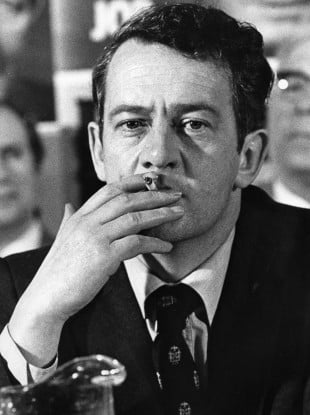
Arming the IRA: according to dramatic reports in London’s Private Eye magazine, the Irish government, which included Des O’Malley as chief whip and junior defence minister, offered the IRA guns and wanted to control who led the IRA.
According to a daft report in The Eye:
“Soon after the August riots in Belfast last year Capt James Kelly, deputy director of Army intelligence, approached the Army Council of the IRA and opened discussions on the acquisition of ‘arms to aid the North’. On the first occasion, Kelly was accompanied by two intelligence officers (one dealing with intelligence on Eastern Europe, the other with counter-British intelligence). On all subsequent meetings with the IRA, Kelly and his officers were accompanied by Mr ‘Jock’ Haughey, brother of the then Minister of Finance. During these discussions on arms, the IRA Army Council were left in no doubt that the intelligence officers were negotiating on behalf of the Minister of Defence, Mr James Gibbons, and the entire Government. As an earnest of the good intentions of the negotiators, a sum of £2,500 was paid to a representative of the I.R.A. allegedly by way of a Catholic priest in North London not unrelated to the then Minister of Finance”.
This, of course, was a reference to Jock Haughey, the brother of Charles.
Foot then reported one of Official Sinn Féin’s most treasured (and nonsensical) core beliefs: The IRA then led by Cathal Goulding, who became leader of the Official IRA after the IRA split in December 1969:
“refused to give information as to their arms contacts (believed, in any event, to be negligible) but agreed to purchase arms for use in the North if money was made available. The government negotiators then demanded conditions from the I.R.A. if the money for arms was to be handed over. These included changes in the I.R.A. leadership and a moratorium on all militant republican activities in the South, such as squatting, anti-landlord demonstrations and the use of arms in the southern 26 counties”.
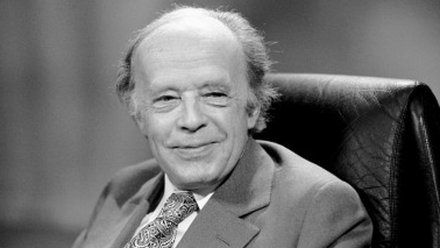
Negotiations with the IRA: if we are to believe Private Eye magazine, Erskine Childers, who later became President of Ireland, was part of a government that offered guns to the IRA on condition they would use them in the North only. Don’t be alarmed, it never happened.
Yes, you read that correctly: the government which included Jack Lynch, Erskine Childers, George Colley, Paddy Hillery and Des O’Malley (as chief whip and junior minister for defence), were demanding changes in personnel at the top of the IRA in return for arming them.
Lynch and his government’s “conditions were not met, and negotiations fizzled out. The impasse provided the opportunity for Mr Jack Lynch and his supporters in the Cabinet (George Colley, Erskine Childers etc) to disentangle themselves from the negotiations with the IRA which they had only agreed to stave off the threatened resignation of five Cabinet ministers (see Eye 202), and serious dissensions in the Army. In his attempt to smear the Haughey/Blaney wing in his party, Lynch had the enthusiastic support of the British Government and the [British] Secret Service, who as [the] summer [of 1970] drew on, were anxious above all to anaesthetise the South against any intervention in the possible northern explosion”.
THE 1971 OFFICIAL SINN FÉIN PAMPHLET
The Officials adhered to a Marxist philosophy which the Provos disdained. Official Sinn Féin and the Official IRA bore the most extreme ill will towards the Provos. By 1971 the Officials were pushing the line that the guns which Captain Kelly had attempted to import in April 1970 had been destined for the Provos. Confused? Don’t worry, you should be. It was all contradictory nonsense.
Official Sinn Féin certainly deserves full marks for the effort they continued to put into their propaganda output: they produced a pamphlet in 1971 and a booklet in 1973, both of which purported to show that Fianna Fáil ministers were involved in this dastardly Provo plot. These publications developed some of the myths described in Private Eye.
Again, Haughey – acting through his brother Jock – was asking the IRA to bend to the will of Fianna Fáil. Jock Haughey had a meeting in London with Cathal Goulding who “informed him that the IRA had a contact to supply arms but that it would not supply small arms and that an initial sum of £50,000 would be needed to start negotiations. Padraic Haughey [i.e. Jock] handed over £1,500 and said that £50,000 would be forthcoming. Several conditions were stipulated, the most important being that the Republican Movement cease political involvement in the South. Subsequently a total of £600 was handed over by Padraic Haughey but his attitude had changed markedly and despite promises never gave any further money”. (p. 24)
When Goulding refused to toe the Fianna Fáil line, the future leaders of the Provisional IRA stepped up to the mark. “The conditions attached to the money were not being met by the IRA leadership [i.e. Goulding] but Captain Kelly [of Military Intelligence] could report that discontented elements in Belfast inside the I.R.A. were amenable and could be talked to”. (p. 24)
After the Arms Crisis erupted, the Provisionals began a bombing campaign in the North. According to Official Sinn Féin they did this to help Haughey. Apparently, by bombing targets in the North, the jury in Dublin was somehow going to be impressed. The pamphlet asserts that, “A series of explosions had taken place in many parts of the North to help build up atmosphere in favour of the accused persons during the trial at the Four Courts. In one of these explosions a man was killed. His death was one of the earlier results of the use of genuine Republicans as Fianna Fáil’s private army in the North”.
So close were the Provisionals – according to Official Sinn Féin – that one of their leaders, “Leo Martin, the former I.R.A. Intelligence Officer in Belfast stated that he was prepared to stand down in favour of Captain Jim Kelly when the election of the Staff [of the IRA] was proceeded with”. (p. 26)
This brings us to another myth so beloved of Official Sinn Féin: that Capt. Kelly set up the Provisional IRA with the backing of Haughey and Blaney. According to Official Sinn Féin, “Captain Kelly then went ahead and attempt to set up a Northern Defence Committee of his own choosing to subvert the IRA throughout the entire North with the help of the Belfast dissidents. Kelly’s liaison men were John and Billy Kelly and Paddy Kennedy MP. [The IRA’s] Head Quarters [in Dublin where Goulding was based], on receiving information as to what is afoot, called a rival meeting in the Oriel hotel, Monaghan, on the same day and frustrated the takeover attempt. At this meeting a Republican Six County Central Defence Committee was established which Captain Kelly was forced, albeit reluctantly, to accept. Captain Kelly had frequent meetings with the Belfast IRA during the months of November, December 1969 and January 1970 as Captain Kelly felt that a breach with the National leadership had been achieved. (p. 26)
According to the Official Sinn Féin fantasy, Haughey did succeed in creating a split out of which emerged the Provisional IRA. “The walkout from the Sinn Fein Ard Fheis at the Intercontinental Hotel in January 1970 and the establishment of the Caretaker Sinn Fein by the breakaway group saw the ultimate victory of the Fianna Fail strategy made public”. (p. 27)
The reasons for the split in the IRA were manifold. Haughey had no hand, act or part in it, as he might have put it himself. Yet, it is amazing how many people believe that he and Blaney played an important role in the split.

William McGrath quickly became one of the most fervent readers of the Official Sinn Féin pamphlet.
A follow up in booklet in 1973 by Official Sinn Féin, entititled ‘Fianna Fail The I.R.A. Connection’, repeated and expanded upon much of what had appeared in the 1971 pamphlet.
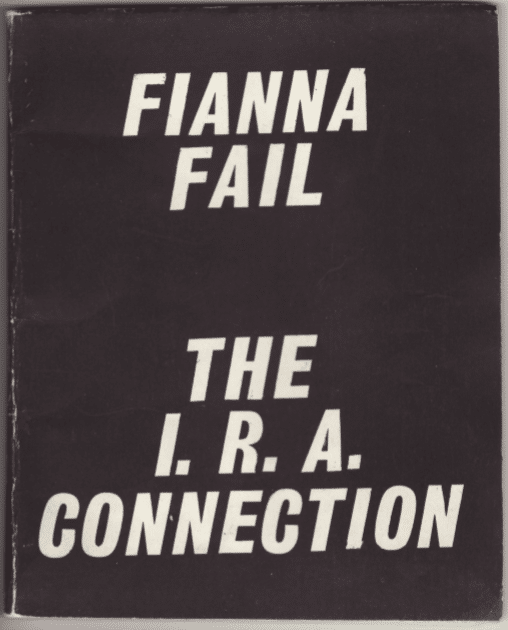
The 1973 booklet.
Books have been written about the Arms Crisis which cite these publications as source material, a story for another day.
1971/2: OFFICIAL SINN FÉIN AND THE SUNDAY TIMES INSIGHT TEAM
Official Sinn Féin agents managed to hypnotise the Sunday Times with a series of dazzling fabrications which emerged in a book published in 1972 by the paper’s lofty sounding Insight team called ‘Ulster’ in 1972.
On this account, Jack Lynch and his cabinet had begun preparations for an invasion of the North in April 1969.
The book – ‘a penguin special’ no less – claimed that on 13 August, 1969, Kevin Boland, a cabinet minister, informed Lynch that he, Haughey and Neil Blaney would resign unless an invasion was ordered so as to create the circumstances for UN troops to intervene and internationalise the situation. Nothing of the sort had happened. Allegedly, ministers Gibbons, Michael O’Móráin (Justice), and Sean Flanagan (Lands), had voiced opinions indicating they might join them. Readers interested in this piece of fiction are directed to page 181 of Ulster. It was all very reminiscent of the Private Eye and Official Sinn Féin pamphlet nonsense.

The 1972 Insight account did not lack for dramatic detail either. The pages claimed that an unnamed doctor in Derry had been delegated to call for an ambulance from a hospital over the Border in Donegal. When it would cross the Craigavon Bridge, it would come under attack from undercover Irish soldiers, something that would give Lynch an excuse to order the invasion. And what brigade would spearhead the attack? Why the non-existent Sixth Brigade of course. According to the Insight team the “shock troops of the so-called Sixth Brigade” which had been “stamping around the Donegal border ever since the RUC’s incursion into the Bogside’ the previous April would launch the attack. “Outraged, the Irish Army would then take Craigavon Bridge” and enter Derry. The Irish Army would then advance “into the South-East and take Lurgan and Toone Bridge, taking control of the top and bottom of Lough Neagh, which separates Belfast from the rest of the province. Derry and Newry – the two Catholic border cities – would be occupied. Reinforcements would be sent in and the Sixth Brigade would advance on Belfast”.
Readers of Insight who believed these yarns must have been greatly impressed by the apparent access the authors had gained to the top-secret planning of the Irish Army. Not only did they learn that it had been stamping around the Border since April but – being thick Micks – they had been doing so with their eyes shut. This was so because their “detailed planning left something to be desired: a camping site outlined on maps provided by GHQ Dublin turned out now to be a council estate”. [p. 180]
The unreliable nature of the information peddled to the Sunday Times can be further gleaned from what they wrote about Haughey’s family background. Haughey had been born in Castlebar, County Mayo before his family moved to Sutton, County Dublin, thence to Dunshauglin, Co Meath. He had spent holidays with his cousins in Derry, near Swatragh. Yet according to Insight, “Haughey, the Minister of Finance, was a native of Swatragh in County Derry and retained bitter childhood memories of his family being forced out of the area under Protestant pressure”. [p. 179]
OTHER STORIES ABOUT THE ARMS CRISIS AND RELATED EVENTS ON THIS WEBSITE:
The Official IRA planned the murders of journalists Ed Moloney and Vincent Browne.
RTE’s ‘Gun Plot’: Why has it taken so long for the true narrative of the Arms Crisis 1970 to emerge?
[Expanded] British Intelligence must have known that Seán MacStíofáin was a Garda ‘informer’.
Captain James Kelly’s family phone was tapped
The long shadow of the Arms Crisis: more to Haughey’s question than meets the eye

Paudge Brennan, the forgotten man of the Arms Crisis
How the Irish Times got its biggest story of the last 50 years wrong.